
 Cute snowmen and snowflake cookies from Elenis.com are some compensation for the colder weather. See other favorite cookies in the Cookies & Brownies section of THE NIBBLE. Cute snowmen and snowflake cookies from Elenis.com are some compensation for the colder weather. See other favorite cookies in the Cookies & Brownies section of THE NIBBLE.

|
 |

December 2006
Gourmet News & Views
Trends, Products & Items of Note In The World Of Specialty Foods
- Click here to return to the main news page
- You can receive the news via RSS by clicking on the RSS box above.
- You also can receive a weekly e-mail with links to this page by subscribing to the News Feed.
December 2006
12.25.06
News
America Loves Sandwiches. Americans purchased $121 billion worth of sandwiches in 2005, according to the latest market research from Packaged Facts, a publisher of consumer market intelligence. While burger spots accounted for 45% of the sandwich market, sandwich chains like Subway and Quiznos realized the greatest revenue growth. Entrepreneur Magazine ranked Subway as the #1 franchise opportunity for 2006. “Sandwich” is a broad term including subs, clubs, gyros, melts, po’boys, muffalettas, wraps, panini and whatever the next evolution brings. Packaged Facts projects that the market will continue to grow exponentially, riding partly on the major success of better sandwich chains. The chains have risen beyond sub shops to hearth-baked artisan breads grilled into paninis and filled with upscale and international ingredients. often inspired by well-known chefs. Beyond the chains, the sandwich business is booming at retail outlets, warehouse clubs and convenience stores.
While our modern sandwich is attributed to John Montague (1718-1792), the Fourth 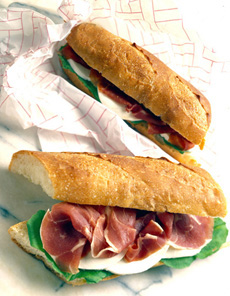 Earl of Sandwich, the practice of putting meat and cheese between bread was not invented by him. A form of sandwich is attributed to the famous Jewish rabbi, Hillel the Elder, who lived during the 1st century B.C. He is said to have placed a mixture of chopped nuts, apples, spices and wine between two matzohs to eat with bitter herbs during Passover, symbolizing the mortar used by the Jews in their forced labor while slaves of the Egyptians. “Hillel sandwiches” are still eaten during the Passover seder. Prior to having the name “sandwich,” the meal was simply called “bread and cheese” or “bread and meat.” As the story comes down, the sandwich was named in 1762 at the London’s Beef Steak Club, a gentlemen’s gaming club. Montague gambled for hours at a time, not stopping for meals, and ordered his valet to bring him meat between two pieces of bread. As Montague was also known by his title, Sandwich, others began to order “the same as Sandwich.” The first printed word referring to the food, Sandwich, also appears that year. You can read more about the history of the sandwich at Epicouros.com. Earl of Sandwich, the practice of putting meat and cheese between bread was not invented by him. A form of sandwich is attributed to the famous Jewish rabbi, Hillel the Elder, who lived during the 1st century B.C. He is said to have placed a mixture of chopped nuts, apples, spices and wine between two matzohs to eat with bitter herbs during Passover, symbolizing the mortar used by the Jews in their forced labor while slaves of the Egyptians. “Hillel sandwiches” are still eaten during the Passover seder. Prior to having the name “sandwich,” the meal was simply called “bread and cheese” or “bread and meat.” As the story comes down, the sandwich was named in 1762 at the London’s Beef Steak Club, a gentlemen’s gaming club. Montague gambled for hours at a time, not stopping for meals, and ordered his valet to bring him meat between two pieces of bread. As Montague was also known by his title, Sandwich, others began to order “the same as Sandwich.” The first printed word referring to the food, Sandwich, also appears that year. You can read more about the history of the sandwich at Epicouros.com.
Photo courtesy of National Pork Board.
Chocolate Combats Fatigue. In recent years, the potential health benefits of dark chocolate have been cited often, referring to its high levels of polyphenols and flavanols which work to protect the body from cell damage. Now, a U.K. study shows that eating a small amount of dark chocolate each day can help combat the symptoms of Chronic Fatigue Syndrome (CFS), according to U.K. researchers. In the study, conducted by Hull and East Yorkshire Hospitals NHS Trust (and available on the Hospitals’ website), researchers fed a group of adults 45g (about 1.5 ounces, more than a newsstand chocolate bar) of specially-formulated dark  chocolate, 85% cacao and rich in polyphenols, every day for eight weeks. The participants reported feeling less fatigued after eating the chocolate and complained of greater fatigue when fed a placebo. Researchers believe that chocolate enhances the action of neurotransmitters such as seratonin, responsible for regulating mood and sleep, which could explain why the product can alleviate Chronic Fatigue Syndrome. This is the first study to examine the effects of chocolate on CFS. No weight gain was reported as a result of the study. chocolate, 85% cacao and rich in polyphenols, every day for eight weeks. The participants reported feeling less fatigued after eating the chocolate and complained of greater fatigue when fed a placebo. Researchers believe that chocolate enhances the action of neurotransmitters such as seratonin, responsible for regulating mood and sleep, which could explain why the product can alleviate Chronic Fatigue Syndrome. This is the first study to examine the effects of chocolate on CFS. No weight gain was reported as a result of the study.
Gloom & Doom In Truffle Land. Droughts have ravaged France’s truffle-producing regions and damaged the highly-prized truffle crops. The rare fungus retails for $1,200 a pound in upscale Parisian gourmet shops. Demand is typically high during the festive 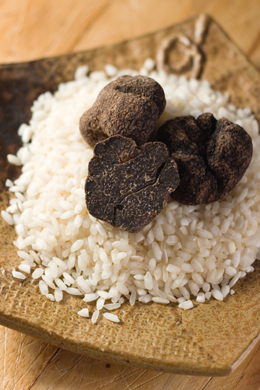 holiday season. In the face of one of Europe's worst droughts, the yield of high-grade truffles has dropped 70 percent over the past four seasons. In 2005, truffle yields among all of France’s truffle-growing regions was about half what it was ten years ago ago. Growth is suffering also in neighboring Italy and Spain, the other two great truffle-growing regions. While truffles grow all over the world in moist, temperate forest climates, very few have culinary value. In fact, thirty varieties can be found in Europe, but only only four black truffles and two varieties of white truffle command attention. With the paucity of truffles in France, authorities fear fraud with the appearance of cheap Chinese imports masquerading as French black truffles. Currently, French black truffles are wholesaling in France for up to $600 a pound, and retailing for double that amount. A pound of Chinese truffles wholesale costs about $60—for good reason: pallid taste. Read an overview of truffles in our feature article, including photos and a truffle glossary. holiday season. In the face of one of Europe's worst droughts, the yield of high-grade truffles has dropped 70 percent over the past four seasons. In 2005, truffle yields among all of France’s truffle-growing regions was about half what it was ten years ago ago. Growth is suffering also in neighboring Italy and Spain, the other two great truffle-growing regions. While truffles grow all over the world in moist, temperate forest climates, very few have culinary value. In fact, thirty varieties can be found in Europe, but only only four black truffles and two varieties of white truffle command attention. With the paucity of truffles in France, authorities fear fraud with the appearance of cheap Chinese imports masquerading as French black truffles. Currently, French black truffles are wholesaling in France for up to $600 a pound, and retailing for double that amount. A pound of Chinese truffles wholesale costs about $60—for good reason: pallid taste. Read an overview of truffles in our feature article, including photos and a truffle glossary.
Photo: The Périgord black truffle, also known as the Winter Black Truffle.
Product Watch
Chocolate-Covered Altoids®. Yes, you heard it right. Wanting to diversify its chewing gum business, the Wm. Wrigley Jr. Co. tried unsuccessfully in 2002 to buy Hershey Co. for $12 billion. Last year it purchased the Altoids 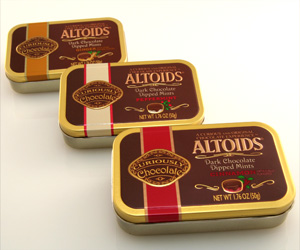 business from Kraft Foods for $1.4 billion. And last week, the world’s largest chewing gum company launched its first chocolate product—and an upscale product, at that. The company rolled out three flavors of Altoids mints covered in 50% cacao dark chocolate. Leveraging the “Curiously” theme used to promote Altoids, the new dark chocolate-dipped mint is called Curiously Chocolate, and is offered in peppermint, cinnamon and ginger flavors. The suggested retail price is $2.49 per tin, 40% higher than the $1.79 suggested retail price for a tin of regular Altoids. The company had planned to introduce the new mint after Christmas, but several major retailers, including Wal-Mart, Target, Walgreens and CVS, asked that it be made available earlier. The mints are round and resemble Goobers® at first glance. The sizzling peppermint, cinnamon and ginger flavors are very refreshing. The chocolate is a brief but nice touch. business from Kraft Foods for $1.4 billion. And last week, the world’s largest chewing gum company launched its first chocolate product—and an upscale product, at that. The company rolled out three flavors of Altoids mints covered in 50% cacao dark chocolate. Leveraging the “Curiously” theme used to promote Altoids, the new dark chocolate-dipped mint is called Curiously Chocolate, and is offered in peppermint, cinnamon and ginger flavors. The suggested retail price is $2.49 per tin, 40% higher than the $1.79 suggested retail price for a tin of regular Altoids. The company had planned to introduce the new mint after Christmas, but several major retailers, including Wal-Mart, Target, Walgreens and CVS, asked that it be made available earlier. The mints are round and resemble Goobers® at first glance. The sizzling peppermint, cinnamon and ginger flavors are very refreshing. The chocolate is a brief but nice touch.
 Yo Ho Ho And A Bottle Of Rogue. Artisan producer Rogue Spirits or Portland, Oregon has introduced Hazelnut Spice Rum. Rum is made by fermenting molasses or sugar cane. This rum is handcrafted by fermenting Hawaiian cane sugar in 567-litre grundies with toasted Oregon hazelnuts, bitter orange peel, Madagascar Bourbon vanilla bean, cinnamon, cloves, dried ginger, Champagne yeast and Free Range Mountain water. Each batch is double-distilled in a process that allows lower-grade alcohols to be extracted, and any remaining impurities are removed through a charcoal filtering process. The rum is then aged in Jack Daniel’s Whiskey barrels and hand-bottled in 750 ml serigraphed bottle. Who is that rogue on the bottle? None other than Edward Teach, better-known as the pirate Black Beard. For more information visit Rogue.com. Yo Ho Ho And A Bottle Of Rogue. Artisan producer Rogue Spirits or Portland, Oregon has introduced Hazelnut Spice Rum. Rum is made by fermenting molasses or sugar cane. This rum is handcrafted by fermenting Hawaiian cane sugar in 567-litre grundies with toasted Oregon hazelnuts, bitter orange peel, Madagascar Bourbon vanilla bean, cinnamon, cloves, dried ginger, Champagne yeast and Free Range Mountain water. Each batch is double-distilled in a process that allows lower-grade alcohols to be extracted, and any remaining impurities are removed through a charcoal filtering process. The rum is then aged in Jack Daniel’s Whiskey barrels and hand-bottled in 750 ml serigraphed bottle. Who is that rogue on the bottle? None other than Edward Teach, better-known as the pirate Black Beard. For more information visit Rogue.com.
Trends
“Craft Beer” Replaces The Microbrew As Beer Rules. Tom Burns began making Boulder Beer in Colorado in 1979. Burt Grant opened a microbrewery in Yakima, Washington in 1982. Bill Owens founded Buffalo Bill’s Brewery greater San Francisco in 1983. This was the beginning of the American microbrew movement. Legally, a microbrewery produces fewer than half a million gallons of beer per year (by comparison, a single Budweiser® plant can produce close to a half billion gallons per year). As Americans embraced the craft of brewing, the term “craft brewery” emerged, defined by some as breweries that produce fewer than 2 million barrels a year. Beer is the alcoholic beverage leader, according to Beer Marketer’s Insights: 55% of alcohol consumed in 2005 was beer, compared with 31% for spirits and 14% for wine. Craft brews still comprise just 4% (206 million barrels), compared with 49% for Anheuser-Busch (maker of Budweiser) 18% for Miller Brewing, 11% for Molson Coors Brewing and 13% for imported beers. Big brewers have taken notice of the popularity of craft and imported beers. Molson Coors produces Blue Moon, a craft-style beer flavored with coriander. Miller’s Leinenkugel brand makes craft-style beers as does Anheuser-Busch, which has recently arranged to import such popular brands as Belgium’s Stella Artois and Germany’s Beck’s.
12.18.06
News
Light Shed On Dark Chocolate. In order to help consumers, the Chocolate 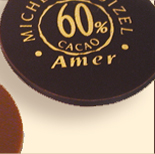 Manufacturers Association (CMA) has released a guide to cacao content labels. Increased publicity about the purported health benefits of dark chocolate has led to increased sales, and many manufacturers have added cacao percentages to their labels. However, consumers easily can make inaccurate assumptions about the corresponding health benefits of the products. While dark chocolate does contain a high content of flavanol antioxidants, it cannot be assumed that the higher the cacao percentage is, the more flavanols the chocolate contains. The actual levels of flavanol content can fluctuate widely depending upon type of bean, recipe, processing, storage and handling Manufacturers Association (CMA) has released a guide to cacao content labels. Increased publicity about the purported health benefits of dark chocolate has led to increased sales, and many manufacturers have added cacao percentages to their labels. However, consumers easily can make inaccurate assumptions about the corresponding health benefits of the products. While dark chocolate does contain a high content of flavanol antioxidants, it cannot be assumed that the higher the cacao percentage is, the more flavanols the chocolate contains. The actual levels of flavanol content can fluctuate widely depending upon type of bean, recipe, processing, storage and handling 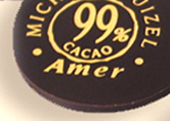 conditions. Therefore, “% cacao” does not indicate a consistent flavanol content from bar to bar. However, a higher cacao percentage does mean a more intense chocolate flavor due the greater chocolate liquor content (except in the case of white chocolate where the cacao content is solely derived from cocoa butter, and the percentage corresponds to the amount of cocoa butter). Similarly, the higher the cacao content, the more bittersweet the chocolate, as it contains a higher percentage of cacao and a lower percentage of sugar. The release can be read at: conditions. Therefore, “% cacao” does not indicate a consistent flavanol content from bar to bar. However, a higher cacao percentage does mean a more intense chocolate flavor due the greater chocolate liquor content (except in the case of white chocolate where the cacao content is solely derived from cocoa butter, and the percentage corresponds to the amount of cocoa butter). Similarly, the higher the cacao content, the more bittersweet the chocolate, as it contains a higher percentage of cacao and a lower percentage of sugar. The release can be read at:
http://www.chocolateusa.org/pdfs/cacao-release.pdf.
Airforce® Nutrisoda® Flies into Schools. Ardea Beverage Company, makers of 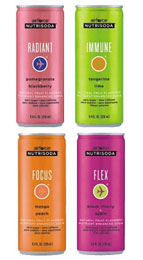 Airforce Nutrisoda, has scored big with U.S. Department of Agriculture. Their nutrient-enhanced, calorie-free (or calorie- negligible) sodas have been selected for inclusion in the U.S. National School Lunch Program. At a time when schools are saying bye-bye to sugar-laden sodas, the USDA is on the hunt for products that can meet their health goals and please the kids. Airforce Nutrisoda’s hip names (Calm, Focus, Radiant, Slender) and packaging in the slender 8.4-ounce cans (popularized by Red Bull®) will no doubt be winners. While tasting good, the sodas contain leading-edge nutrients including amino acids, vitamins, minerals and herbs. Of course, the line was developed for adults. If you’d like to offer your holiday guests an alternative to the ubiquitous diet cola, lay in a stock. Read our full review of Airforce Nutrisoda. Airforce Nutrisoda, has scored big with U.S. Department of Agriculture. Their nutrient-enhanced, calorie-free (or calorie- negligible) sodas have been selected for inclusion in the U.S. National School Lunch Program. At a time when schools are saying bye-bye to sugar-laden sodas, the USDA is on the hunt for products that can meet their health goals and please the kids. Airforce Nutrisoda’s hip names (Calm, Focus, Radiant, Slender) and packaging in the slender 8.4-ounce cans (popularized by Red Bull®) will no doubt be winners. While tasting good, the sodas contain leading-edge nutrients including amino acids, vitamins, minerals and herbs. Of course, the line was developed for adults. If you’d like to offer your holiday guests an alternative to the ubiquitous diet cola, lay in a stock. Read our full review of Airforce Nutrisoda.
12.10.06
Product Watch
Artisan Panettone. If you enjoy panettone, the wonderful Italian sweet yeast bread studded with fruits, here’s your chance to get one from one of the top panettone 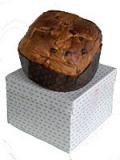 artisans of Italy, Angelo Marchesi of Milan’s Pasticceria Marchesi. Panettone is the holiday cake in Italy during the Christmas season: It is served at every meal (we love making French toast with it). Marchesi, a family of artisan bakers who have worked in the same shop since 1824, uses the best and freshest ingredients, no preservatives or additives. All phases of production and packaging are by hand. Panettone Milanese Classico by Marchesi, a 1 kg (2.2 pounds) bread, beautifully boxed, is s available at Italian specialty food importer Gustiamo, while supplies last. $50.00. artisans of Italy, Angelo Marchesi of Milan’s Pasticceria Marchesi. Panettone is the holiday cake in Italy during the Christmas season: It is served at every meal (we love making French toast with it). Marchesi, a family of artisan bakers who have worked in the same shop since 1824, uses the best and freshest ingredients, no preservatives or additives. All phases of production and packaging are by hand. Panettone Milanese Classico by Marchesi, a 1 kg (2.2 pounds) bread, beautifully boxed, is s available at Italian specialty food importer Gustiamo, while supplies last. $50.00.
http://www.gustiamo.com/pages/PAN.shtml.
Sorry, Charlie, It’s Gourmet. Following on the heels of G’Day Gourmet flavored tunas, one of our favorite products of the year, StarKist® is introducing its own line of flavored tunas, in Lemon Dill and Roasted Garlic. While G’Day Gourmet uses the more flavorful skipjack tuna, Starkist is using the more popular (in America) Yellowfin and Albacore tunas. Exactly when the tunas will be available is uncertain: a news release dated December 12, 2006 says that they will appear in “the canned food aisle this fall.” Phone calls to the company for clarification were not returned. Perhaps we should have asked for Charlie instead of their media representative.
Another brand of Del Monte Foods is also keeping up with the times by extending their organic line. Del Monte® Organic tomato products were launched last year, to enthusiastic consumer reception. The company has just announced the launch of five new organic products, including Del Monte Organic corn, green beans and peas, as well as College Inn® Organic beef and chicken broths. The organic category has grown 89% between 2001 and 2005, and is expected to continue growing at a rate of 18% annually through 2009.
Trends
Restaurant Trends. Americans spend 47.9 percent of their food budget in restaurants, and are expected to spend 5 percent more in 2007, for a total of $537 billion (yes, including tips). According to the National Restaurant Association’s survey of more than 1,000 chefs, some of the hottest menu trends are bite-sized desserts, locally grown and organic produce, flatbread and bottled water. Hot ingredients include artisan salts, exotic mushrooms, figs, fresh herbs, ginger, grass-fed and free-range meat, pomegranates, whole-grain breads and focaccia. Latin American, Mediterranean, and Pan Asian and fusion cuisines rule. Paralleling what’s happening in the nation’s supermarkets, the survey showed increased popularity of organic items.
Profession At Peril: Wine Steward. Prepaid cards work for phone services and gas. Is wine next? The Enomatic, a new self-serve wine dispenser from Chianti, Italy, may revolutionize casual restaurant and bar wine service. From self-serve stations recessed into walls, there 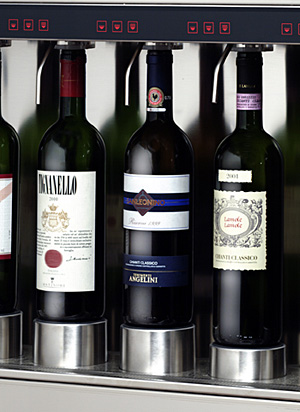 can be 48 or more bottles, which are rotated frequently to offer different selections to the regulars. The technology, which has swept through Europe and recently started appearing in the U.S., where there are about 25 installations of the system at the moment. The system ensures control of quality, quantity and temperature, and it allows people to learn about new wines. The machine keeps wines fresh for up to six weeks and allows patrons to taste wines using a debit-type card. Customers can choose 1-, 3- or 6-ounce pours without bothering the bartender. They simply swipe the debit-like card, insert the glass under the spigot, and select their wine and pour size (think of it as the Wine Automat). The machine pours the wine in the glass and then deducts the cost from the prepaid card. At Naples Tomato in North Naples, Florida, prices range from $1.50 to $30, depending on the wine and the size selected. The restaurant’s wine list has 600 choices; at any time, the Enomatic has 70 wines by the glass, representing every country, grape and popular vintage. One of the most expensive pours comes from a bottle of Chateau d’Yquem, the world’s greatest Sauternes. At $450 a bottle, a 1-ounce taste is $22, making it more affordable for people to try the legendary dessert wine. Customers buy cards in amounts ranging from $25 to $500, which ensures the establishment repeat business (at least until the competition puts in an Enomatic). Given the potential to asking for recommendations from strangers at the serving station, the Enomatic may become a new social meeting place as well....and lead to splitting a 1-ounce taste of Yquem for dessert. can be 48 or more bottles, which are rotated frequently to offer different selections to the regulars. The technology, which has swept through Europe and recently started appearing in the U.S., where there are about 25 installations of the system at the moment. The system ensures control of quality, quantity and temperature, and it allows people to learn about new wines. The machine keeps wines fresh for up to six weeks and allows patrons to taste wines using a debit-type card. Customers can choose 1-, 3- or 6-ounce pours without bothering the bartender. They simply swipe the debit-like card, insert the glass under the spigot, and select their wine and pour size (think of it as the Wine Automat). The machine pours the wine in the glass and then deducts the cost from the prepaid card. At Naples Tomato in North Naples, Florida, prices range from $1.50 to $30, depending on the wine and the size selected. The restaurant’s wine list has 600 choices; at any time, the Enomatic has 70 wines by the glass, representing every country, grape and popular vintage. One of the most expensive pours comes from a bottle of Chateau d’Yquem, the world’s greatest Sauternes. At $450 a bottle, a 1-ounce taste is $22, making it more affordable for people to try the legendary dessert wine. Customers buy cards in amounts ranging from $25 to $500, which ensures the establishment repeat business (at least until the competition puts in an Enomatic). Given the potential to asking for recommendations from strangers at the serving station, the Enomatic may become a new social meeting place as well....and lead to splitting a 1-ounce taste of Yquem for dessert.
12.10.06
Product Watch
Recchiuti Invents A Better Chocolate Wrapper. Understanding that people who 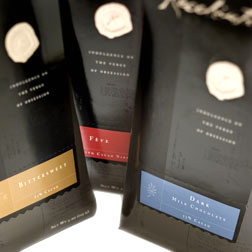 like fine chocolate want portion control, top chocolatier Michael Recchiuti has invented a better chocolate bar wrapper. His 4-ounce gourmet bars now come in re-closable pouches, enabling the consumer to break off a chunk and reseal for freshness. A trio of the bars, tied with an elegant satin bow, makes a nice gift for the chocolate-lover: 85% cacao Bittersweet Chocolate, 55% cacao Dark Milk Chocolate and Fève (the Bittersweet bar with crunchy cacao nibs). The bars, regularly $7 each, are $18.00 for the trio. At Recchiuti.com. like fine chocolate want portion control, top chocolatier Michael Recchiuti has invented a better chocolate bar wrapper. His 4-ounce gourmet bars now come in re-closable pouches, enabling the consumer to break off a chunk and reseal for freshness. A trio of the bars, tied with an elegant satin bow, makes a nice gift for the chocolate-lover: 85% cacao Bittersweet Chocolate, 55% cacao Dark Milk Chocolate and Fève (the Bittersweet bar with crunchy cacao nibs). The bars, regularly $7 each, are $18.00 for the trio. At Recchiuti.com.
Candy Lovers Are All Shook Up. Hershey’s will release a limited Elvis edition of its Reese’s candy in a peanut butter/banana crème flavor to coincide with the 30th anniversary of the King’s death next August. The flavor pays homage to Elvis’ favorite sandwich, deep fried peanut butter and banana. Elvis has been one of the steadiest sales generators, he was the number one revenue-generator in the Forbes ranking of dead celebrities until this year, when he came in second behind Nirvana’s Kurt Cobain. Still, the King pulled in $42 million in sales, down $3 million from the previous year. Perhaps the Elvis Reese’s will get him back on top.
Pasta For Diabetics. Pasta raises the blood sugar levels of diabetics, so they have to cut it out of their diets. When native-born Italian and Chicago restaurateur Charles Galletta, learned he had diabetes and could no longer enjoy the pasta he served his customers, he dedicated himself to fining a solution. Using a white bean extract called StarchLite®, which has been clinically shown to delay the digestion and absorption of carbohydrates, he experimented with recipes that would reduce the absorption of starch. The result: Molinari Mills Carbolina Low-Calorie Pasta with StarchLite contain about the same number of calories (210) and carbohydrates (41 grams) as other dried semolina pastas. The manufacturer claims, however, that only 5 grams of carbohydrates are actually digested. In appearance and taste, the cooked pasta can’t be distinguished from major brands of regular pasta. Several studies have shown that the starch-blocking ingredient in Carbolina, phaseolamin, is non-toxic. Limited studies suggest that it does lessen the impact of carbohydrates on blood-sugar levels. Carbolina is currently available only in a 10-ounce package of penne rigate. E-commerce will be up on the website any day now. MolinariMills.com.
Trends
The Upscaling Of Fast Food. For the past month, McDonald’s Corp. has been testing hamburgers made with Angus beef at six Los Angeles-area restaurants, trying out products that would go head-to-head with Burger King’s line of higher-end burgers. 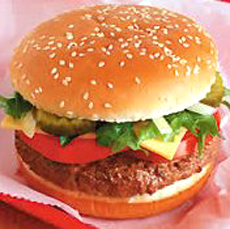 Angus Third Pounders, including an Angus with cheese, an Angus Deluxe with lettuce and tomato and an Angus Mushroom and Swiss, sell for between $3.39 and $3.99. By comparison, the top-selling double cheeseburger costs $1. Over the last three years, McDonald’s has recently revitalized sales with chicken products like Chicken Selects chicken strips, Premium Chicken Sandwiches, and, most recently, the chicken Snack Wrap. During that time, competitors like Burger King, Carl’s Jr. and Hardee’s have benefited from adding bigger, fancier hamburgers to their menus. If the Angus burgers make it to McDonald’s permanent menu, they just might cause the need to raise the bar again. McKobe, anyone? Angus Third Pounders, including an Angus with cheese, an Angus Deluxe with lettuce and tomato and an Angus Mushroom and Swiss, sell for between $3.39 and $3.99. By comparison, the top-selling double cheeseburger costs $1. Over the last three years, McDonald’s has recently revitalized sales with chicken products like Chicken Selects chicken strips, Premium Chicken Sandwiches, and, most recently, the chicken Snack Wrap. During that time, competitors like Burger King, Carl’s Jr. and Hardee’s have benefited from adding bigger, fancier hamburgers to their menus. If the Angus burgers make it to McDonald’s permanent menu, they just might cause the need to raise the bar again. McKobe, anyone?
Career Change: Become A Chocolatier. Some notable chocolatiers used to do something else entirely. Joan Coukos of Chocolat Moderne was an investment banker, Kee Ling Tong, of  Kee’s Chocolates in new York City’s SoHo, and Mary Leonard of Chocolat Celeste in Minneapolis, both left successful executive positions in the corporate world to make fine chocolate. They took courses and apprenticed with top chocolatiers. But if you can’t do the same, there is another way—an online home study program from Ecole Chocolat in Vancouver. Jonathan Spillane, a chocolate-lover and full-time carpenter, took the course and left carpentry to found Cocoapelli chocolates (the name comes from the fertility god Kokopelli). He converted his Natick, Massachusetts garage into a chocolate studio and now produces about 100 eight-ounce boxes of chocolates every other week, including a Key Lime Ganache, Kona Coffee Ganache and three different caramels. You can purchase the chocolates at CocoapelliChocolates.com or by telephone at 1.508.655.1195. Kee’s Chocolates in new York City’s SoHo, and Mary Leonard of Chocolat Celeste in Minneapolis, both left successful executive positions in the corporate world to make fine chocolate. They took courses and apprenticed with top chocolatiers. But if you can’t do the same, there is another way—an online home study program from Ecole Chocolat in Vancouver. Jonathan Spillane, a chocolate-lover and full-time carpenter, took the course and left carpentry to found Cocoapelli chocolates (the name comes from the fertility god Kokopelli). He converted his Natick, Massachusetts garage into a chocolate studio and now produces about 100 eight-ounce boxes of chocolates every other week, including a Key Lime Ganache, Kona Coffee Ganache and three different caramels. You can purchase the chocolates at CocoapelliChocolates.com or by telephone at 1.508.655.1195.
Coffee Trends Up. Owing to the pervasive Starbucks culture, after a downward spiral, coffee is dominant again. For the first time since 1990, American adults now drink almost as much coffee as soft drinks. According to the National Coffee Association, 56% of Americans drink it every day. Consumers are not only drinking more coffee, but with more varieties and finer varieties available, are expanding their horizons. A survey undertaken by the Association earlier this year showed that recent growth in demand was driven by the 25-39 year-age group, with daily use in that crowd reaching 47% in 2006 from 38% in 2004. Demand among those 18-24 years of age rose to 31% in 2006 from 22% in 2004. Among seniors, traditionally big coffee drinkers, 73% drank the beverage in 2006, versus 67% in 2004. The new U.S. café culture, fostered by Starbucks and other chains that have made coffee shops ubiquitous both for takeout and social meetings, has helped to encourage young adults—a group that typically drank other beverages—to drink coffee. New supermarket and specialty food products also have lifted demand. And, recent research has also shown coffee to be good for one’s health, as opposed to the old suppositions that it “stunts one’s growth” and is otherwise bad for health. The U.S. is the world’s top coffee consumer, drinking nearly 21 million bags of beans annually. The European Union, by contrast, drinks almost 39 million bags a year, with per-capita consumption particularly high in northern Europe. Specialty or “gourmet” beans account for 15% of U.S. sales.
12.4.06
News
Visit A Gourmet Chocolate Factory. Vere (pronounced “very”), a fine chocolate 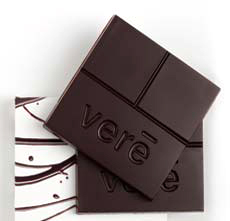 company based in New York, is opening its factory doors to provide chocolate fans with an opportunity to peek inside a boutique chocolate factory. The premises will be open to the public from Wednesday, December 13th through Friday, December 15th, 10:00 a.m. to 6:00p.m. Visitors will be offered a 20% discount on purchases of the high-antioxidant, low-glycemic gourmet chocolate. The factory is located at 12 West 27th Street, 6th floor, in Manhattan. Read more about Vere chocolate, made of 75% Arriba Nacional cacao, in our product review. company based in New York, is opening its factory doors to provide chocolate fans with an opportunity to peek inside a boutique chocolate factory. The premises will be open to the public from Wednesday, December 13th through Friday, December 15th, 10:00 a.m. to 6:00p.m. Visitors will be offered a 20% discount on purchases of the high-antioxidant, low-glycemic gourmet chocolate. The factory is located at 12 West 27th Street, 6th floor, in Manhattan. Read more about Vere chocolate, made of 75% Arriba Nacional cacao, in our product review.
Product Watch
Innovation For More Perfect Bananas. Chiquita Brands International, Inc. is test-marketing a new line of specially-wrapped bananas that will let consumers enjoy their bananas at a perfect stage of ripeness. Sold under the name Chiquita Fresh & Ready, the banana three-packs use a permeable plastic wrap that allows oxygen in and lets carbon dioxide out, which slows the ripening process. Each banana is sealed separately. Thus, a shopper who buys six bananas can open three right away but let three others ripen for the following week. The first innovation in bananas to come down from the trees in years, this modern convenience is fetching prices of up to $1.90 per pack, more than double what bananas typically cost. Chiquita and retailers are betting that consumers will pay more for a banana that stays ripe at least four days longer. Americans, unlike consumers in other nations, will not eat bananas with too much browning. Ten Publix Supermarkets  in South Florida and 14 in Nashville, Tennessee were among the first retailers to sell the new Chiquita product. in South Florida and 14 in Nashville, Tennessee were among the first retailers to sell the new Chiquita product.
Trends
Flavored Vodka. In 2005, 46 million cases of vodka were sold in the U.S., 90 percent of them plain. But industry analysts say that the remaining 10 percent—premium-flavored vodka—is driving vodka’s future. Van Gogh Vodka (VanGoghVodka.com), which comes in 16 flavors (more than any producer), sells for $25 to $29 a bottle. We tasted many of them at a show earlier this year and found them to be first-rate, which we can’t say for every newbie brand jumping on the flavor bandwagon. Flavored vodkas have exploded onto bar shelves, where they’re a hit with everyone: young and old, women and men, college kids and boomers. While they mix into groovy cocktails, they also taste great straight-up. Coffee-lovers will flip for Van Gogh’s coffee flavors: we highly recommend the Double Espresso as a holiday gift. For those keeping count, Absolut is the best-selling imported vodka and Grey Goose is second. Smirnoff is the best-selling vodka overall, with sales twice that of Absolut, but it’s neither imported nor considered a premium brand.
Roast Your Own. Some coffee connoisseurs are so particular, they roast their own beans at home. One of the big complaints among home roasters about the country’s large coffee chains is that they tend to produce very dark roasts, masking the subtle flavor differences, or “origin character,” of beans grown in different countries. Home roasting is a small but growing trend, according to an article in the Associated Press. It doesn’t require a lot of time, money or equipment to roast coffee beans at home—less than 10 minutes. There are countertop electric roasters that cost anywhere from $75 to $500, but an air popcorn popper does the trick, turning flavorless green coffee beans into savory brown kernels. Home roasters feel that their worst batches are fresher than any they’d buy in a store. In just a few minutes, you can roast your 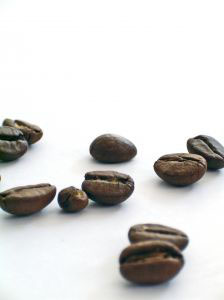 beans, then grind and brew them for the freshest cup of coffee you’ve ever had. One convert to home roasting calls it “the difference between a tomato bought in the supermarket and one grown in your garden.” Home roasters congregate at websites such as CoffeeGeek.com, where they exchange techniques. Perhaps the most popular purveyor of green coffee beans, according to the Associated Press, is Oakland-based SweetMarias.com, which sells around 400,000 pounds of green beans a year, offering customers more than 60 varieties from Central America, Africa and Asia. Prices range from $4.45 to $29.90 a pound. Deans.Beans.com, an organic coffee specialist in Orange, Massachusetts, also sells green beans. TheCaptainsCoffee.com, launched in 2003 in North Carolina, is another source, selling 18,000 pounds a year. Proprietor Dennis Robbins first learned about home roasting while listening to a radio program about coffee. If you love your java, it may be a fun project for the new year. Try roasting your beans in the popcorn popper, or even in a skillet on the stove. If you like it, spring for the expensive equipment. beans, then grind and brew them for the freshest cup of coffee you’ve ever had. One convert to home roasting calls it “the difference between a tomato bought in the supermarket and one grown in your garden.” Home roasters congregate at websites such as CoffeeGeek.com, where they exchange techniques. Perhaps the most popular purveyor of green coffee beans, according to the Associated Press, is Oakland-based SweetMarias.com, which sells around 400,000 pounds of green beans a year, offering customers more than 60 varieties from Central America, Africa and Asia. Prices range from $4.45 to $29.90 a pound. Deans.Beans.com, an organic coffee specialist in Orange, Massachusetts, also sells green beans. TheCaptainsCoffee.com, launched in 2003 in North Carolina, is another source, selling 18,000 pounds a year. Proprietor Dennis Robbins first learned about home roasting while listening to a radio program about coffee. If you love your java, it may be a fun project for the new year. Try roasting your beans in the popcorn popper, or even in a skillet on the stove. If you like it, spring for the expensive equipment.

News Archives
| |
4th Quarter 2006 |
3rd Quarter 2006 |
| |
|
|
| 2nd Quarter 2006 |
1st Quarter 2006 |
4th Quarter 2005 |
|
|
|
| 3rd Quarter 2005 |
2nd Quarter 2005 |
1st Quarter 2005 |
|
|
|
Send your product news to:
Info at TheNibble. com.
Substitute @ for at . We use this convention to avoid address-harvesting spam spiders.
Don’t Miss The News:
Subscribe To Our Gourmet News & Views News Feed
Lifestyle Direct Direct, Inc. All rights reserved. Images are the copyright of their respective owners.

|




 Cute snowmen and snowflake cookies from Elenis.com are some compensation for the colder weather. See other
Cute snowmen and snowflake cookies from Elenis.com are some compensation for the colder weather. See other 
 Earl of Sandwich, the practice of putting meat and cheese between bread was not invented by him. A form of sandwich is attributed to the famous Jewish rabbi, Hillel the Elder, who lived during the 1st century B.C. He is said to have placed a mixture of chopped nuts, apples, spices and wine between two matzohs to eat with bitter herbs during Passover, symbolizing the mortar used by the Jews in their forced labor while slaves of the Egyptians. “Hillel sandwiches” are still eaten during the Passover seder. Prior to having the name “sandwich,” the meal was simply called “bread and cheese” or “bread and meat.” As the story comes down, the sandwich was named in 1762 at the London’s Beef Steak Club, a gentlemen’s gaming club. Montague gambled for hours at a time, not stopping for meals, and ordered his valet to bring him meat between two pieces of bread. As Montague was also known by his title, Sandwich, others began to order “the same as Sandwich.” The first printed word referring to the food, Sandwich, also appears that year. You can read more about the history of the sandwich at
Earl of Sandwich, the practice of putting meat and cheese between bread was not invented by him. A form of sandwich is attributed to the famous Jewish rabbi, Hillel the Elder, who lived during the 1st century B.C. He is said to have placed a mixture of chopped nuts, apples, spices and wine between two matzohs to eat with bitter herbs during Passover, symbolizing the mortar used by the Jews in their forced labor while slaves of the Egyptians. “Hillel sandwiches” are still eaten during the Passover seder. Prior to having the name “sandwich,” the meal was simply called “bread and cheese” or “bread and meat.” As the story comes down, the sandwich was named in 1762 at the London’s Beef Steak Club, a gentlemen’s gaming club. Montague gambled for hours at a time, not stopping for meals, and ordered his valet to bring him meat between two pieces of bread. As Montague was also known by his title, Sandwich, others began to order “the same as Sandwich.” The first printed word referring to the food, Sandwich, also appears that year. You can read more about the history of the sandwich at  chocolate, 85% cacao and rich in polyphenols, every day for eight weeks. The participants reported feeling less fatigued after eating the chocolate and complained of greater fatigue when fed a placebo. Researchers believe that chocolate enhances the action of neurotransmitters such as seratonin, responsible for regulating mood and sleep, which could explain why the product can alleviate Chronic Fatigue Syndrome. This is the first study to examine the effects of chocolate on CFS. No weight gain was reported as a result of the study.
chocolate, 85% cacao and rich in polyphenols, every day for eight weeks. The participants reported feeling less fatigued after eating the chocolate and complained of greater fatigue when fed a placebo. Researchers believe that chocolate enhances the action of neurotransmitters such as seratonin, responsible for regulating mood and sleep, which could explain why the product can alleviate Chronic Fatigue Syndrome. This is the first study to examine the effects of chocolate on CFS. No weight gain was reported as a result of the study. holiday season. In the face of one of Europe's worst droughts, the yield of high-grade truffles has dropped 70 percent over the past four seasons. In 2005, truffle yields among all of France’s truffle-growing regions was about half what it was ten years ago ago. Growth is suffering also in neighboring Italy and Spain, the other two great truffle-growing regions. While truffles grow all over the world in moist, temperate forest climates, very few have culinary value. In fact, thirty varieties can be found in Europe, but only only four black truffles and two varieties of white truffle command attention. With the paucity of truffles in France, authorities fear fraud with the appearance of cheap Chinese imports masquerading as French black truffles. Currently, French black truffles are wholesaling in France for up to $600 a pound, and retailing for double that amount. A pound of Chinese truffles wholesale costs about $60—for good reason: pallid taste. Read
holiday season. In the face of one of Europe's worst droughts, the yield of high-grade truffles has dropped 70 percent over the past four seasons. In 2005, truffle yields among all of France’s truffle-growing regions was about half what it was ten years ago ago. Growth is suffering also in neighboring Italy and Spain, the other two great truffle-growing regions. While truffles grow all over the world in moist, temperate forest climates, very few have culinary value. In fact, thirty varieties can be found in Europe, but only only four black truffles and two varieties of white truffle command attention. With the paucity of truffles in France, authorities fear fraud with the appearance of cheap Chinese imports masquerading as French black truffles. Currently, French black truffles are wholesaling in France for up to $600 a pound, and retailing for double that amount. A pound of Chinese truffles wholesale costs about $60—for good reason: pallid taste. Read  business from Kraft Foods for $1.4 billion. And last week, the world’s largest chewing gum company launched its first chocolate product—and an upscale product, at that. The company rolled out three flavors of Altoids mints covered in 50% cacao dark chocolate. Leveraging the “Curiously” theme used to promote Altoids, the new dark chocolate-dipped mint is called Curiously Chocolate, and is offered in peppermint, cinnamon and ginger flavors. The suggested retail price is $2.49 per tin, 40% higher than the $1.79 suggested retail price for a tin of regular Altoids. The company had planned to introduce the new mint after Christmas, but several major retailers, including Wal-Mart, Target, Walgreens and CVS, asked that it be made available earlier. The mints are round and resemble Goobers® at first glance. The sizzling peppermint, cinnamon and ginger flavors are very refreshing. The chocolate is a brief but nice touch.
business from Kraft Foods for $1.4 billion. And last week, the world’s largest chewing gum company launched its first chocolate product—and an upscale product, at that. The company rolled out three flavors of Altoids mints covered in 50% cacao dark chocolate. Leveraging the “Curiously” theme used to promote Altoids, the new dark chocolate-dipped mint is called Curiously Chocolate, and is offered in peppermint, cinnamon and ginger flavors. The suggested retail price is $2.49 per tin, 40% higher than the $1.79 suggested retail price for a tin of regular Altoids. The company had planned to introduce the new mint after Christmas, but several major retailers, including Wal-Mart, Target, Walgreens and CVS, asked that it be made available earlier. The mints are round and resemble Goobers® at first glance. The sizzling peppermint, cinnamon and ginger flavors are very refreshing. The chocolate is a brief but nice touch. Yo Ho Ho And A Bottle Of Rogue.
Yo Ho Ho And A Bottle Of Rogue. Manufacturers Association (CMA) has released a guide to cacao content labels. Increased publicity about the purported health benefits of dark chocolate has led to increased sales, and many manufacturers have added cacao percentages to their labels. However, consumers easily can make inaccurate assumptions about the corresponding health benefits of the products. While dark chocolate does contain a high content of flavanol antioxidants, it cannot be assumed that the higher the cacao percentage is, the more flavanols the chocolate contains. The actual levels of flavanol content can fluctuate widely depending upon type of bean, recipe, processing, storage and handling
Manufacturers Association (CMA) has released a guide to cacao content labels. Increased publicity about the purported health benefits of dark chocolate has led to increased sales, and many manufacturers have added cacao percentages to their labels. However, consumers easily can make inaccurate assumptions about the corresponding health benefits of the products. While dark chocolate does contain a high content of flavanol antioxidants, it cannot be assumed that the higher the cacao percentage is, the more flavanols the chocolate contains. The actual levels of flavanol content can fluctuate widely depending upon type of bean, recipe, processing, storage and handling  conditions. Therefore, “% cacao” does not indicate a consistent flavanol content from bar to bar. However, a higher cacao percentage does mean a more intense chocolate flavor due the greater chocolate liquor content (except in the case of white chocolate where the cacao content is solely derived from cocoa butter, and the percentage corresponds to the amount of cocoa butter). Similarly, the higher the cacao content, the more bittersweet the chocolate, as it contains a higher percentage of cacao and a lower percentage of sugar. The release can be read at:
conditions. Therefore, “% cacao” does not indicate a consistent flavanol content from bar to bar. However, a higher cacao percentage does mean a more intense chocolate flavor due the greater chocolate liquor content (except in the case of white chocolate where the cacao content is solely derived from cocoa butter, and the percentage corresponds to the amount of cocoa butter). Similarly, the higher the cacao content, the more bittersweet the chocolate, as it contains a higher percentage of cacao and a lower percentage of sugar. The release can be read at: Airforce Nutrisoda, has scored big with U.S. Department of Agriculture. Their nutrient-enhanced, calorie-free (or calorie- negligible) sodas have been selected for inclusion in the U.S. National School Lunch Program. At a time when schools are saying bye-bye to sugar-laden sodas, the USDA is on the hunt for products that can meet their health goals and please the kids. Airforce Nutrisoda’s hip names (Calm, Focus, Radiant, Slender) and packaging in the slender 8.4-ounce cans (popularized by Red Bull®) will no doubt be winners. While tasting good, the sodas contain leading-edge nutrients including amino acids, vitamins, minerals and herbs. Of course, the line was developed for adults. If you’d like to offer your holiday guests an alternative to the ubiquitous diet cola, lay in a stock. Read our full
Airforce Nutrisoda, has scored big with U.S. Department of Agriculture. Their nutrient-enhanced, calorie-free (or calorie- negligible) sodas have been selected for inclusion in the U.S. National School Lunch Program. At a time when schools are saying bye-bye to sugar-laden sodas, the USDA is on the hunt for products that can meet their health goals and please the kids. Airforce Nutrisoda’s hip names (Calm, Focus, Radiant, Slender) and packaging in the slender 8.4-ounce cans (popularized by Red Bull®) will no doubt be winners. While tasting good, the sodas contain leading-edge nutrients including amino acids, vitamins, minerals and herbs. Of course, the line was developed for adults. If you’d like to offer your holiday guests an alternative to the ubiquitous diet cola, lay in a stock. Read our full 
 can be 48 or more bottles, which are rotated frequently to offer different selections to the regulars. The technology, which has swept through Europe and recently started appearing in the U.S., where there are about 25 installations of the system at the moment. The system ensures control of quality, quantity and temperature, and it allows people to learn about new wines. The machine keeps wines fresh for up to six weeks and allows patrons to taste wines using a debit-type card. Customers can choose 1-, 3- or 6-ounce pours without bothering the bartender. They simply swipe the debit-like card, insert the glass under the spigot, and select their wine and pour size (think of it as the Wine Automat). The machine pours the wine in the glass and then deducts the cost from the prepaid card. At Naples Tomato in North Naples, Florida, prices range from $1.50 to $30, depending on the wine and the size selected. The restaurant’s wine list has 600 choices; at any time, the Enomatic has 70 wines by the glass, representing every country, grape and popular vintage. One of the most expensive pours comes from a bottle of Chateau d’Yquem, the world’s greatest Sauternes. At $450 a bottle, a 1-ounce taste is $22, making it more affordable for people to try the legendary dessert wine. Customers buy cards in amounts ranging from $25 to $500, which ensures the establishment repeat business (at least until the competition puts in an Enomatic). Given the potential to asking for recommendations from strangers at the serving station, the Enomatic may become a new social meeting place as well....and lead to splitting a 1-ounce taste of Yquem for dessert.
can be 48 or more bottles, which are rotated frequently to offer different selections to the regulars. The technology, which has swept through Europe and recently started appearing in the U.S., where there are about 25 installations of the system at the moment. The system ensures control of quality, quantity and temperature, and it allows people to learn about new wines. The machine keeps wines fresh for up to six weeks and allows patrons to taste wines using a debit-type card. Customers can choose 1-, 3- or 6-ounce pours without bothering the bartender. They simply swipe the debit-like card, insert the glass under the spigot, and select their wine and pour size (think of it as the Wine Automat). The machine pours the wine in the glass and then deducts the cost from the prepaid card. At Naples Tomato in North Naples, Florida, prices range from $1.50 to $30, depending on the wine and the size selected. The restaurant’s wine list has 600 choices; at any time, the Enomatic has 70 wines by the glass, representing every country, grape and popular vintage. One of the most expensive pours comes from a bottle of Chateau d’Yquem, the world’s greatest Sauternes. At $450 a bottle, a 1-ounce taste is $22, making it more affordable for people to try the legendary dessert wine. Customers buy cards in amounts ranging from $25 to $500, which ensures the establishment repeat business (at least until the competition puts in an Enomatic). Given the potential to asking for recommendations from strangers at the serving station, the Enomatic may become a new social meeting place as well....and lead to splitting a 1-ounce taste of Yquem for dessert.  like fine chocolate want portion control, top chocolatier Michael Recchiuti has invented a better chocolate bar wrapper. His 4-ounce gourmet bars now come in re-closable pouches, enabling the consumer to break off a chunk and reseal for freshness. A trio of the bars, tied with an elegant satin bow, makes a nice gift for the chocolate-lover: 85% cacao Bittersweet Chocolate, 55% cacao Dark Milk Chocolate and Fève (the Bittersweet bar with crunchy cacao nibs). The bars, regularly $7 each, are $18.00 for the trio. At Recchiuti.com.
like fine chocolate want portion control, top chocolatier Michael Recchiuti has invented a better chocolate bar wrapper. His 4-ounce gourmet bars now come in re-closable pouches, enabling the consumer to break off a chunk and reseal for freshness. A trio of the bars, tied with an elegant satin bow, makes a nice gift for the chocolate-lover: 85% cacao Bittersweet Chocolate, 55% cacao Dark Milk Chocolate and Fève (the Bittersweet bar with crunchy cacao nibs). The bars, regularly $7 each, are $18.00 for the trio. At Recchiuti.com.  Angus Third Pounders, including an Angus with cheese, an Angus Deluxe with lettuce and tomato and an Angus Mushroom and Swiss, sell for between $3.39 and $3.99. By comparison, the top-selling double cheeseburger costs $1. Over the last three years, McDonald’s has recently revitalized sales with chicken products like Chicken Selects chicken strips, Premium Chicken Sandwiches, and, most recently, the chicken Snack Wrap. During that time, competitors like Burger King, Carl’s Jr. and Hardee’s have benefited from adding bigger, fancier hamburgers to their menus. If the Angus burgers make it to McDonald’s permanent menu, they just might cause the need to raise the bar again. McKobe, anyone?
Angus Third Pounders, including an Angus with cheese, an Angus Deluxe with lettuce and tomato and an Angus Mushroom and Swiss, sell for between $3.39 and $3.99. By comparison, the top-selling double cheeseburger costs $1. Over the last three years, McDonald’s has recently revitalized sales with chicken products like Chicken Selects chicken strips, Premium Chicken Sandwiches, and, most recently, the chicken Snack Wrap. During that time, competitors like Burger King, Carl’s Jr. and Hardee’s have benefited from adding bigger, fancier hamburgers to their menus. If the Angus burgers make it to McDonald’s permanent menu, they just might cause the need to raise the bar again. McKobe, anyone? company based in New York, is opening its factory doors to provide chocolate fans with an opportunity to peek inside a boutique chocolate factory. The premises will be open to the public from Wednesday, December 13th through Friday, December 15th, 10:00 a.m. to 6:00p.m. Visitors will be offered a 20% discount on purchases of the high-antioxidant, low-glycemic gourmet chocolate. The factory is located at 12 West 27th Street, 6th floor, in Manhattan. Read more about
company based in New York, is opening its factory doors to provide chocolate fans with an opportunity to peek inside a boutique chocolate factory. The premises will be open to the public from Wednesday, December 13th through Friday, December 15th, 10:00 a.m. to 6:00p.m. Visitors will be offered a 20% discount on purchases of the high-antioxidant, low-glycemic gourmet chocolate. The factory is located at 12 West 27th Street, 6th floor, in Manhattan. Read more about 
 beans, then grind and brew them for the freshest cup of coffee you’ve ever had. One convert to home roasting calls it “the difference between a tomato bought in the supermarket and one grown in your garden.” Home roasters congregate at websites such as CoffeeGeek.com, where they exchange techniques. Perhaps the most popular purveyor of green coffee beans, according to the Associated Press, is Oakland-based SweetMarias.com, which sells around 400,000 pounds of green beans a year, offering customers more than 60 varieties from Central America, Africa and Asia. Prices range from $4.45 to $29.90 a pound. Deans.Beans.com, an organic coffee specialist in Orange, Massachusetts, also sells green beans. TheCaptainsCoffee.com, launched in 2003 in North Carolina, is another source, selling 18,000 pounds a year. Proprietor Dennis Robbins first learned about home roasting while listening to a radio program about coffee. If you love your java, it may be a fun project for the new year. Try roasting your beans in the popcorn popper, or even in a skillet on the stove. If you like it, spring for the expensive equipment.
beans, then grind and brew them for the freshest cup of coffee you’ve ever had. One convert to home roasting calls it “the difference between a tomato bought in the supermarket and one grown in your garden.” Home roasters congregate at websites such as CoffeeGeek.com, where they exchange techniques. Perhaps the most popular purveyor of green coffee beans, according to the Associated Press, is Oakland-based SweetMarias.com, which sells around 400,000 pounds of green beans a year, offering customers more than 60 varieties from Central America, Africa and Asia. Prices range from $4.45 to $29.90 a pound. Deans.Beans.com, an organic coffee specialist in Orange, Massachusetts, also sells green beans. TheCaptainsCoffee.com, launched in 2003 in North Carolina, is another source, selling 18,000 pounds a year. Proprietor Dennis Robbins first learned about home roasting while listening to a radio program about coffee. If you love your java, it may be a fun project for the new year. Try roasting your beans in the popcorn popper, or even in a skillet on the stove. If you like it, spring for the expensive equipment.